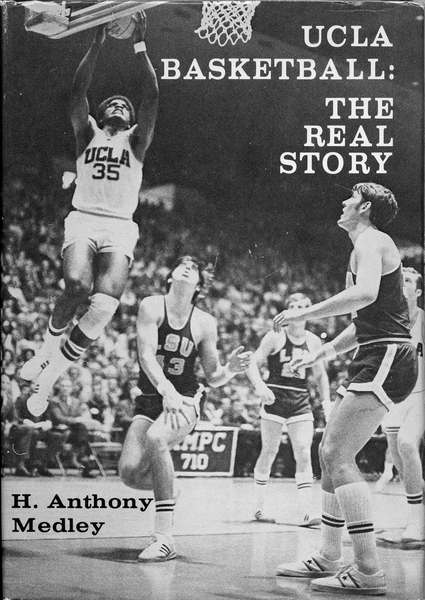|
Out of print for more than 30 years, now available for the first time as an eBook, this is the controversial story of John Wooden's first 25 years and first 8 NCAA Championships as UCLA Head Basketball Coach. This is the only book that gives a true picture of the character of John Wooden and the influence of his assistant, Jerry Norman, whose contributions Wooden ignored and tried to bury. Compiled with more than 40 hours of interviews with Coach Wooden, learn about the man behind the coach. The players tell their stories in their own words. Click the book to read the first chapter and for ordering information. Also available on Kindle. |
|
Sports Medley: NBC’s Olympics Coverage 22 Aug 16 by Tony Medley Bring Back Jim McKay: The men’s volleyball announcers were the pits. In a U.S.-Mexico match in the second set, there was a Mexico challenge on an alleged net violation. Depending on the outcome, it would have been 6-2 or 5-3. All the time during the challenge the announcers were talking about how Mexico got into the tournament, completely ignoring the challenge and not showing any replay or even telling what the challenge was about. When Mexico won the challenge they did not mention that the score reverted to 5-3. As if that weren’t bad enough, the entire crew then missed another point talking about all the Nittany Lions playing on the team, showing closeups of those players without showing the point! Worse, NBC’s audience is in America. Maybe NBC doesn’t realize this, but America is not on the metric system. However, when showing numbers, like in the high jump, NBC’s graphics were in meters, not feet and inches. To most American viewers, metric measurements are not comprehensible. Back in the day, we had the 7 foot high jump barrier (conquered by Charlie Dumas in the 1956 Olympic Trials at the Los Angeles Coliseum) and the 60 foot shot-put barrier (conquered by Parry O’Brien at the Coliseum in 1954). If converted to meters, the 7 foot barrier would have been 2.1336, and the 60 foot shot-put barrier would have been 18.288, which are, let’s face it, meaningless numbers to Americans. It gets even worse. In covering field events like the pole vault and high jump, they didn’t show each try, which is where the tension is. All they showed were winning jumps and maybe final tries. Where’s the interest in that? That’s like showing the last ten meters of the 100 meter dash. But, hey, they showed every foot run in the 26 mile marathon. Volleyball Celebrations: Why do volleyball players celebrate after every winning point as if they’ve won the lottery? Tennis Celebrations: Finally, there was a realistic celebration by someone winning a tournament. Instead of the phony, contrived, falling to the ground that has become de rigueur in most Grand Slams, when Bethanie Mattek-Sands won the mixed doubles Gold Medal, she jumped into the arms of her partner, Jack Sock, and hugged him and then just kept jumping up and down in pure delight. This was a realistic, human reaction of joy. Tennis needs more of that and less of the manufactured, artificial reaction of players falling to the ground after they win, which has never been a natural way to express happiness. Last Add Tennis: Tennis should dump the “let” serve rule where if the serve hits the net, the serve is replayed (the late Bud Collins, the Commentator Laureate of tennis, labeled every let court judge, who sat with his fingers on the net to see if the ball nicked it, “Fingers Fortescue”). There is no such thing as a “let” in volleyball and it works out fine. If the serve hits the net, they just continue to play the point. In tennis if the serve hits the net, then tennis players should just have to live with it and take it as part of the game, as do volleyball players. If a ball hits the net during a tennis rally, they don’t stop the point and replay it. Why should it be any different if the serve hits the net? More on Wilt Chamberlain’s prowess as a volleyball player: ESPN has been touting Wilt’s volleyball prowess for years. Here’s what Jeff Merron wrote for ESPN’s Page 2 in 2004, “After he retired from basketball, the Dipper transformed himself into a world-class volleyball player.” After my last week’s column was published pooh-pooing an ESPN talking head recently claiming on ESPN’s Mike & Mike in the Morning that Wilt was “the greatest volleyball player in history,” I received an email from a 3 time Volleyball All American who was on the 1959 American volleyball team that won the Gold Medal in the Pan Am Games who also played on John Wooden’s first UCLA basketball teams. He wrote, “You're right on the money with Wilt. He had suction cups for hands. He couldn't pass or bump the ball with any consistency.” The bottom line is that Wilt was tall and could jump and spike but other than that he was neither “the best” nor even “world class,” as ESPN continues to claim. Who knows better, a bunch of sportswriters and sportscasters who were born after Wilt retired and never saw him play, or the people who played with and against him?
|
|
|
